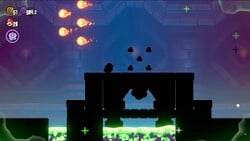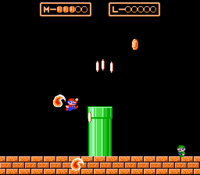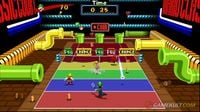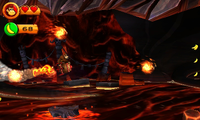Fireball (obstacle): Difference between revisions
No edit summary |
mNo edit summary |
||
| Line 5: | Line 5: | ||
|latest_appearance=''[[WarioWare: Move It!]]'' ([[List of games by date#2023|2023]]) | |latest_appearance=''[[WarioWare: Move It!]]'' ([[List of games by date#2023|2023]]) | ||
}} | }} | ||
'''Fireballs''' (alternatively '''fire balls'''<ref>''{{cite|title=Mario Bros.'' instruction booklet|page=8|author=Nintendo|publisher=Nintendo of America|date=1985|language=American English}}</ref> or '''Fire Balls'''<ref>{{cite|author=Williams, Drew|title=''Yoshi's Island: Super Mario Advance 3'' Player's Guide|date=2002|page=4|publisher=[[Nintendo Power]]|language=American English|isbn=1-930206-25-9}}</ref>), also called '''Discs''',<ref>Instruction manual for Amstrad CPC, Commodore 64, and ZX Spectrum ports of ''Mario Bros.''</ref> '''Fires''',<ref>{{cite|title=''Mario Clash'' instruction booklet|page=18 and 22|date=1995|publisher=Nintendo of America|language=American English|author=Nintendo}}</ref> or '''swirls''',<ref>{{cite|title=''Nintendo Power Advance'' Volume 1|page=40|date=Spring 2001|publisher=[[Nintendo Power]]|language=American English}}</ref> in the [[Super Mario (franchise)|''Super Mario'' franchise]] | '''Fireballs''' (alternatively '''fire balls'''<ref>''{{cite|title=Mario Bros.'' instruction booklet|page=8|author=Nintendo|publisher=Nintendo of America|date=1985|language=American English}}</ref> or '''Fire Balls'''<ref>{{cite|author=Williams, Drew|title=''Yoshi's Island: Super Mario Advance 3'' Player's Guide|date=2002|page=4|publisher=[[Nintendo Power]]|language=American English|isbn=1-930206-25-9}}</ref>), also called '''Discs''',<ref>Instruction manual for Amstrad CPC, Commodore 64, and ZX Spectrum ports of ''Mario Bros.''</ref> '''Fires''',<ref>{{cite|title=''Mario Clash'' instruction booklet|page=18 and 22|date=1995|publisher=Nintendo of America|language=American English|author=Nintendo}}</ref> or '''swirls''',<ref>{{cite|title=''Nintendo Power Advance'' Volume 1|page=40|date=Spring 2001|publisher=[[Nintendo Power]]|language=American English}}</ref> in the [[Super Mario (franchise)|''Super Mario'' franchise]] sometimes appear in the context of being obstacles, but are most commonly used by [[Mario]], [[Bowser]], and other characters as means of attack. | ||
==History== | ==History== | ||
===''Mario Bros.'' series=== | ===''Mario Bros.'' series=== | ||
Revision as of 06:41, May 11, 2024
- This article is about the Mario Bros. enemy. For other uses, see Fireball (disambiguation).
| Fireball | |
|---|---|
 Fireballs, as they appear in Super Mario Bros. Wonder | |
| First appearance | Mario Bros. (1983) |
| Latest appearance | WarioWare: Move It! (2023) |
Fireballs (alternatively fire balls[1] or Fire Balls[2]), also called Discs,[3] Fires,[4] or swirls,[5] in the Super Mario franchise sometimes appear in the context of being obstacles, but are most commonly used by Mario, Bowser, and other characters as means of attack.
History
Mario Bros. series
Mario Bros.

Fireballs in Mario Bros. make their first appearance in a Super Mario game. They appear in red and green varieties, and are unique enemies in that they cannot cross the left or right edge of the screen and come out on the other side. There can be a maximum of four fireballs, two of each color, on screen at any given time. Fireballs and Icicles are the only enemies that can harm players hiding behind the bottom pipes. A fireball will appear to impede the player if they take too long to complete a phase. Red fireballs are slower and bounce diagonally all around the stage, and if they hit one side of the screen, they ricochet off the side and keep going until making a full circuit of the screen after which they will disappear and respawn as a faster opponent. The quicker green fireballs[6] move horizontally from one side of the screen to the other where it will disappear until respawning elsewhere. It has a pattern of two small wavy bounces and one long bounce. Typically, the green fireballs spawn on a row where a player is located. To destroy fireballs, the player has to bump them from below while they are touching the floor, or use a POW Block. Fireballs respawn as faster enemies a few moments after being destroyed.
In the Atari 2600 port, fireballs are orange but behave like the green types from the original. It flies straight forward very quickly. In the Atari 5200 port, the orange fireball takes the place of the red one while the green one is replaced by the gold fireball. In the PC-8001 port, there is only one red fireball and it can travel through the wraparound screen. In the Commodore 64 port, there is a single red fireball but it behaves like the green fireball from the arcade version. In the Amstrad CPC and ZX Spectrum ports, the single fireball will float to the bottom floor as if it was affected by gravity and just roll around continuously. In the Atari 7800 port, the red type is called the orange fireball but it looks purplish. In the Atari 8-bit port, the red and green types are replaced by orange and blue respectively.
In the 1983 Family Computer port, fireballs are significantly smaller, making them easier to avoid. They were restored to their correct size by the 1988 FDS port and 1993 NES port.
Fireballs in the Mario Bros. game of Super Mario Bros. 3 are all depicted red, but some behave like green fireballs. In addition, there is a bonus stage in which fireballs are shot out of a pipe. The in-game battle mode in its Super Mario All-Stars version also has both fireballs using the red sprite, while the Battle Game in the main menu replaces the sprites with Boos, which can go through the wraparound screen.
Fireballs in Luigi Bros. of Super Mario 3D World function identically to their appearance in the Family Computer port of Mario Bros.
Mario Bros. Special
Fireballs in Mario Bros. Special appear in red and green varieties, both of which are invincible. Green fireballs in the game appear only in trampoline stages and have a sharper angle to their turn with a pattern of alternating broad and narrow waves. Red fireballs in the game appear only in conveyor belt stages and patrol a narrow range.
Punch Ball Mario Bros.
Fireballs in Punch Ball Mario Bros. are invincible and look red. They act like green fireballs, but with a simpler wave pattern.
Mario Clash
Fire in Mario Clash, as they are called, function like the green fireballs from Mario Bros. but with a simpler wave pattern. They can be destroyed with a Turtle Shell.
VS. Wrecking Crew / Wrecking Crew
Fireballs in VS. Wrecking Crew and Wrecking Crew behave like the green fireballs of Mario Bros. but with a simpler wavy pattern. A fireball will appear if too much time is spent in one place. Careful positioning can allow the fireball to fly harmlessly over Mario or Luigi's head. The in-game manual of the Arcade Archives release of VS. Wrecking Crew classifies fireballs as characters.[7]
Hotel Mario
Balls of fire in Hotel Mario are obstacles in Bowser's Seizures Palace Hotel. They are preceded by a match-striking sound, and then dart from one end of a floor to another horizontally. In certain stages, more than one ball can appear at once. If they appear on the same floor as the player, the player can duck underneath them or hide into a door to avoid them. Alternatively, if the player is Fire Mario, they can shoot a fireball at one of them, which will make them stop spawning for the remainder of the hotel.
Super Mario series
Super Mario 64 / Super Mario 64 DS
Fireballs in Super Mario 64 and its Nintendo DS version are very common obstacles featured as both standalone objects and enemy projectiles. Stationary ones light torches in the Mushroom Castle and Hazy Maze Cave, and they are shot out in large groups by the volcano in Lethal Lava Land. They can also be shot by flame throwers, Fly Guys, Small Piranhas, Piranha Flowers, and Bowser, with some staying still and others chasing Mario. In the remake, stationary fireballs also light small bonfires at Cool, Cool Mountain and Snowman's Land, and they can be eaten by Yoshi for fire breath.
Super Mario Galaxy / Super Mario Galaxy 2
Fireballs in Super Mario Galaxy and Super Mario Galaxy 2 move in circular patterns, either through the air or coming out of lava, appearing as an arc. They appear in places like the Freezeflame Galaxy, the Melty Molten Galaxy, the lava pool in the Freezy Flake Galaxy, and the Melty Monster Galaxy. Unlike most depictions, these fireballs have long, burning tails. A small, rolling variety can be spawned by Magikoopas, and in the former game, is in fact the only object generic Magikoopas can spawn in gameplay with their main attack. Kamella also uses this and Koopa Shells during her fights, and becomes more likely to summon fireballs as she takes damage.
Super Mario Bros. Wonder
Fireballs in Super Mario Bros. Wonder are obstacles spawned from hazardous ooze. They are first encountered during the level Fluff-Puff Peaks Palace. The direction in which a fireball moves depends, but if a character touches one, they take damage.
Mario Power Tennis
Green fireballs from Mario Bros. in Mario Power Tennis are obstacles bouncing around the court in the minigame Coin Collectors. These fireballs can stun a player for three seconds on contact as the defeated sound effect from Mario Bros. is heard playing.
Donkey Kong franchise
Donkey Kong Jungle Beat
Fireballs in Donkey Kong Jungle Beat are recurring lava obstacles that may travel straight or in arcs, and usually leap from magma. Fireballs in the game first appear in the level Grim Volcano.
Donkey Kong Country series
Fireballs in the Donkey Kong Country series first appear in Donkey Kong Country Returns and return in the Nintendo 3DS version, then in Donkey Kong Country: Tropical Freeze shortly afterward. In all games, they appear as a type of hazard capable of damaging the Kongs.
Fireballs in Donkey Kong Country Returns appear as hazards during a short section of Hot Rocket.[8] They come out from behind and fly across the screen, destroying the Kongs' Rocket Barrel and causing them to lose a life if they come into contact. However, if avoided, fireballs simply fly past them. Fireballs cannot be stopped or destroyed. At one point, a fireball crashes into a chunk of rock falling from the ceiling, destroying it and revealing a Puzzle Piece.
Fireballs in Donkey Kong Country: Tropical Freeze appear in Scorch 'n' Torch, where they drop from baobab canopies at regular intervals and fall into pits below. Fireballs can only be destroyed with a Water Sack.
Profiles
Perfect Ban Mario Character Daijiten
Gallery
A fireball produced by Roger the Potted Ghost in Super Mario World 2: Yoshi's Island
A green fire in WarioWare: D.I.Y. Showcase, as an obstacle in 18-Volt's Dustpan microgame
Two fireballs raining down in front of Donkey Kong in Donkey Kong Country: Tropical Freeze
Names in other languages
| Language | Name | Meaning | Notes |
|---|---|---|---|
| Japanese | ファイアボール[9][10] Faiabōru |
Fireball | |
| ファイア[11] Faia |
Fire | ||
Honō |
Flame | ||
| French (NOE) | Boule de Feu[13] | Fire Ball | |
| German | Feuerball[13] | Fireball | |
| Italian | Fiamma[14] | Flame | |
| Sfera di fuoco[13] | Fire sphere | ||
| Palla di fuoco (NES Remix)[?] | Fire ball | ||
| Spanish (NOE) | Bola de fuego[13] | Fire Ball |
References
- ^ Nintendo (1985). Mario Bros. instruction booklet. Nintendo of America (American English). Page 8.
- ^ Williams, Drew (2002). Yoshi's Island: Super Mario Advance 3 Player's Guide. Nintendo Power (American English). ISBN 1-930206-25-9. Page 4.
- ^ Instruction manual for Amstrad CPC, Commodore 64, and ZX Spectrum ports of Mario Bros.
- ^ Nintendo (1995). Mario Clash instruction booklet. Nintendo of America (American English). Page 18 and 22.
- ^ Spring 2001. Nintendo Power Advance Volume 1. Nintendo Power (American English). Page 40.
- ^ Mario Bros. Atari 7800 game manual, Scoring page.
- ^ Arcade Archives VS. Wrecking Crew in-game manual. Page 7.
- ^ "As some fireballs come at you from behind, try to fly in the middle." – Knight, Michael (2010). Donkey Kong Country Returns Prima Official Game Guide. Prima Games. ISBN 978-0-307-47102-4. Page 140.
- ^ Nintendo (1985). レッキングクルー (Rekkingu Kurū) instruction booklet. Nintendo (Japanese). Page 5.
- ^ Cite error: Invalid
<ref>tag; no text was provided for refs namedDaijiten - ^ Nintendo (1995). マリオクラッシュ (Mario Kurasshu) instruction booklet. Nintendo (Japanese). Page 16 and 20.
- ^ Nintendo (1998). Wrecking Crew '98 physical release manual. Nintendo. Page 15.
- ^ a b c d 2001. Super Mario Advance European instruction booklet (PDF). Nintendo of Europe (Italian). Page 38, 58, 98, and 118. Retrieved April 6, 2019.
- ^ Super Mario Bros. 3 Italian manual, pag. 28
- Fire creatures
- Hazardous objects
- Donkey Kong Jungle Beat objects
- Donkey Kong Country Returns objects
- Donkey Kong Country: Tropical Freeze objects
- Hotel Mario enemies
- Mario Bros. enemies
- Mario Clash enemies
- Super Mario 64 objects
- Super Mario Bros. Wonder objects
- Super Mario Galaxy objects
- Super Mario Galaxy 2 objects
- VS. Wrecking Crew
- Wrecking Crew









